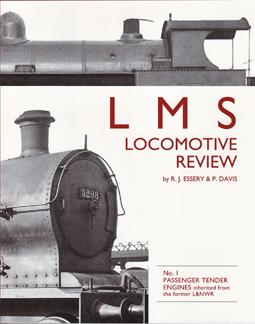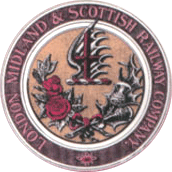LMS Locomotive Review
No.1 PASSENGER TENDER ENGINES inherited from the former L&NWR
by R.J. Essery & P. Davis
ISBN 978 1 908763 03 7
Price £27.95
Published December 2013
Contents
|

|
FOREWORD
The question of what the LMS inherited from the constituent and subsidiary companies has often been considered in regular planning meetings for the LMS Journal. As far as we could see, the subject is not one to have commanded much attention from other authors and begs the question, what did the LMS inherit, how good was it and how long did it last before the new company replaced these assets?
This question could be directed to a variety of subjects ranging from fixed structures,signalling, livery, locomotives and rolling stock and even company identity, but we have chosen to begin our investigation with the largest constituent company of the LMS, the London & North Western Railway and to deal with its stock of locomotives. Self styled 'The Premier Line', it was formed in 1846 by the amalgamation of the London & Birmingham, Grand junction (an 1845 amalgamation of itself with the Liverpool & Manchester and several minor Lancashire companies) and Manchester & Birmingham Railways. When considering the L&NWR prior to the 1923 grouping, we must also consider the North London Railway, a line that was incorporated by an Act of 26th August 1846 as the East and West India Docks and Birmingham Junction Railway. In December 1908, an agreement to last twenty-one years was entered into between the North London and London & North Western Railway Companies to the effect that the North London would continue to exist as a separate corporation, but their senior officers would be retired and their places taken by the corresponding officers from the L&NWR.
There was also the Lancashire & Yorkshire Railway Company, the origins of which lay in a number of small lines that came together in 1847 assuming the title Lancashire &; Yorkshire Railway. Terms for amalgamation were agreed between the L&NW and L&Y in December 1921 and from 1st January 1922 the combined system was operated as one railway. For the purpose of this work, the locomotives of the Lancashire & Yorkshire Railway are excluded, but the locomotive stock of the North London Railway are included. Although it is not possible or even desirable to ignore the pre-1923 history, it is not intended to delve into the various aspects of LNWR locomotive history so beloved by some writers. The question of the suitability of Webb's designs, in particular his compounds, will not form part of this work; indeed the publisher and I take the view that the LMS inherited all manner of mechanical items from the constituent and subsidiary companies and, that the quality varied, but they became LMS stock, and the purpose of these books is to record, as objectively as possible, what it was and how it fared during the years that followed. Therefore, in many respects, this is a 'broad brush' approach and no attempt has been made to include every minor detail that affected every class of locomotives. Nevertheless, this illustrated survey has taken many pages, so we have divided it into three manageable volumes, the first covering passenger tender classes, the second the tank engine classes, and the third the goods tender engines.
The information in this work has been compiled from a number of sources, the majority of them secondary, and when crosschecking it became clear that not all the dates and facts quoted were identical. While every effort has been made to crosscheck them, the lack of prime source material means that information given may be at variance with other published works on the subject. There are many ways of interpreting historical fact and we hope this work will be seen as accurate and comprehensive and add to our knowledge of the story of LNWR locomotives during the post-1923 period.
The final point is addressed to those readers who are also railway modellers. Experience as editor and publisher of both LMS Journal and Midland Record has shown us that many readers use these titles as a source of reference and information for modelling projects, so accurate detail information is important to them, therefore we will try to be mindful of their needs.
Bob Essery




